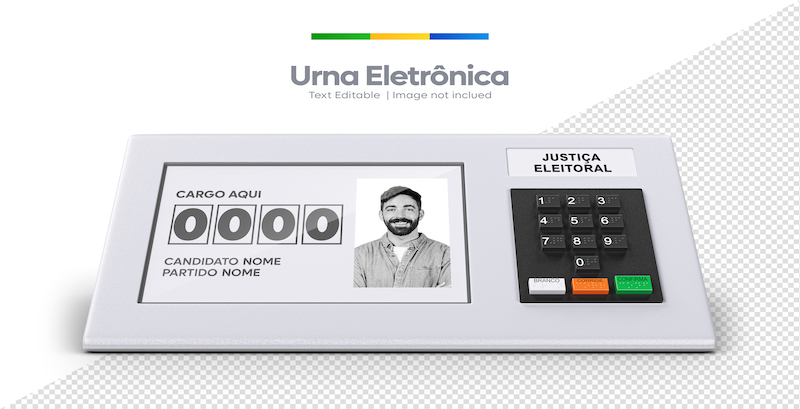Brazil, one of the first countries to adopt electronic voting on a large scale
The digitization of the electoral process in Brazil is a story of technological and social transformation that began in the 1990s and has had a profound impact on the way elections are held in the country. Brazil, one of the first countries to adopt electronic voting on a large scale, is often cited as an international example in the implementation of digital voting technologies.
Context and Implementation
Before the introduction of electronic ballot boxes, the voting process in Brazil was carried out completely manually. Paper ballots were the standard method, where voters marked their votes by hand, and these ballots were then counted by election officials. This traditional system, although simple, had several significant disadvantages. Among the main ones was the susceptibility to counting errors and fraud, problems aggravated by the need for complex logistics for the distribution and collection of ballot boxes in a continental territory like Brazil. In addition, the counting of votes could be extremely time-consuming, often taking days or even weeks to complete, resulting in substantial delays in the announcement of election results.

The scenario began to change after the 1994 elections, which highlighted the urgent need to revise and modernize the Brazilian electoral system. The complexity and challenges inherent in the paper-based voting process have highlighted the need for a more efficient and secure approach. It was in this context that, in 1996, Brazil took a significant step towards modernizing its electoral system with the implementation of electronic ballot boxes. This technology was introduced with the promise of speeding up the voting and counting process, as well as reducing the vulnerabilities associated with the previous system.
Electronic ballot boxes were initially implemented in cities with more than 200,000 voters. This strategic choice allowed the system to be tested in a controlled environment, but still significantly challenging due to the high population density. The success seen in the first implementations was decisive for the gradual expansion of the system. This initial phase proved that the use of technology was viable and brought tangible improvements to the integrity and efficiency of the electoral process.
By the 2000 elections, the electronic ballot box system had been expanded to achieve nationwide coverage, marking an era of digital transformation in Brazilian elections. The switch to an electronic system not only simplified the logistics of ballot box distribution and collection, but also minimized the risks of fraud and human error in the vote count. With digitalization, the counting of results has become faster and more transparent, making it possible to announce the results within a few hours of the polls closing.
This technological advance in the Brazilian electoral system reflected a global trend of using information technologies to improve governance and public administration. The electronic ballot boxes represented a milestone in Brazil’s commitment to promoting fairer, more accessible and more secure elections. Brazil’s experience with digitizing the electoral process serves as an example for other nations seeking methods to improve the efficiency and security of their electoral processes, showing how technological innovation can be applied to strengthen democracy.
Electronic voting technology
Brazil’s electronic voting machines are a crucial component of the country’s electoral system, developed to guarantee the accessibility, security and integrity of elections. First implemented in 1996, these ballot boxes represent a remarkable example of how technology can be used to reinforce democratic principles.
The design of the electronic ballot boxes is deliberately simple and functional, allowing voters of all ages and literacy levels to use the system without difficulty. The user interface, consisting of a numeric keypad and a screen, facilitates the voting process by allowing the voter to enter the number of their candidate and confirm their choice visually on the screen before finalizing their vote. This procedure not only reduces the likelihood of errors, but also strengthens voters’ confidence that their votes are being correctly recorded.

One of the main aspects of electronic voting machines is the robustness of their security system. These machines operate completely disconnected from the internet and any external networks during the voting process, an essential preventative measure to protect the system from possible cyber attacks and external manipulation. In addition, the ballot box software is rigorously developed and maintained under the supervision of the Superior Electoral Court (TSE), ensuring that it is always up-to-date and secure against known vulnerabilities.
To ensure the integrity of the electoral system, the TSE carries out public security tests before each election, inviting information security experts from all over the country to evaluate and test the electronic ballot boxes. These tests not only help to identify and correct possible flaws, but also promote the transparency of the electoral process by allowing independent experts to verify the reliability of the system.
Despite the advances made by the electronic ballot box, the system still faces challenges and criticism, especially regarding the lack of a printed proof of vote. Critics of this approach argue that printing vouchers would increase transparency and facilitate independent audits, contributing to greater confidence in election results.
In response to these concerns, the TSE has been investigating ways to further improve confidence in the electoral system. Measures such as constantly updating security practices and exploiting new technologies are essential to maintaining public confidence in the electoral process. These efforts demonstrate an ongoing commitment to improving the access, security and transparency of elections in Brazil.
Electronic voting machines in Brazil are therefore a vital part of the country’s democratic infrastructure. They exemplify how technological innovations can be effectively applied to improve the electoral process, despite the criticisms and challenges that persist. The ongoing commitment to improving the security and reliability of the electoral system is fundamental to maintaining and strengthening Brazilian democracy.
Impacts of Digitalization
The introduction of electronic voting machines in Brazil revolutionized the electoral process, bringing substantial improvements in several areas. Among the most notable benefits is the speeding up of the counting of votes. Before digitization, vote counting could take several days, creating a prolonged period of uncertainty that could generate tension and distrust in the electoral process. With electronic ballot boxes, this counting can be done in a matter of hours after the polls close, giving citizens and candidates an almost immediate response. This advance not only improved the efficiency of the system, but also contributed to democratic stability by minimizing the windows of opportunity for challenges based on the delay of results.
As well as speeding up the vote count, digitization has also brought about a significant reduction in the number of invalid and blank votes. The interface of the electronic ballot boxes has been designed to be intuitive and easy to use, which helps to guide the voter through the voting process, reducing filling errors that were common in the previous system. This clarity in the voting process is essential to ensure that all votes are counted correctly, more accurately reflecting the will of the electorate.
Another important benefit of the electronic system is increased security against fraud. In the paper ballot system, there was constant concern about the possibility of votes being added, removed or altered, especially during transportation and counting. Electronic voting machines have eliminated these vulnerabilities by completely digitizing the voting process. Each vote is recorded electronically and stored securely in the ballot box itself, which prevents undue alterations and guarantees greater electoral integrity.
These transformations have strengthened confidence in the Brazilian electoral system, although the electronic ballot box system is not free from challenges and criticisms, especially related to transparency and verification of results. However, the benefits introduced by the digitalization of the electoral process are indisputable. They not only modernized the way elections are conducted in Brazil, but also reinforced the democratic principles of efficiency, accuracy and security. Thus, the adoption of electronic voting machines represents a significant step in the quest for an electoral process that meets the expectations of an increasingly informed and demanding electorate.
Challenges and Criticism
Despite its successes, Brazil’s electronic voting system is not without its critics and challenges. One of the main points of contention is the lack of a printed voting receipt, which would allow independent verification of the electronic results. Critics argue that without a physical audit trail, it is difficult for voters and political parties to check whether the results have been manipulated.
Furthermore, although electronic ballot boxes are designed to be secure, concerns remain about possible cyber vulnerabilities, especially in an increasingly connected world. The TSE continues to work on the continuous improvement of ballot box security, responding to concerns with regular testing and software updates.
The journey to improve the electoral process is ongoing
The digitization of the electoral process in Brazil serves as a clear example of the potential of technology to improve the efficiency and security of elections. The introduction of electronic voting machines has revolutionized the way votes are recorded and counted in the country, bringing significant advances and addressing many of the logistical and integrity challenges that marked previous systems. Despite the obvious benefits, the system is not without its challenges and criticisms, particularly in relation to transparency and security against cyber threats.

The journey to improve the electoral process is ongoing. Constant investment in new technologies, along with efforts to increase transparency and strengthen security measures, is crucial. These actions are fundamental to sustaining and raising citizens’ confidence in the electoral system. Public acceptance of the electronic voting system depends on confidence in its ability to accurately and securely record every vote and transparently reflect the will of the people.
Therefore, Brazil must continue to dedicate itself to finding innovative solutions that address both existing concerns and those that may arise in the future. Maintaining an open dialog with society about how the system works and how it is being improved is also vital to strengthening the legitimacy and effectiveness of the electoral process. Digitalization is undoubtedly a milestone in Brazilian electoral history, but it is only one step towards an increasingly fair, secure and transparent electoral system.











